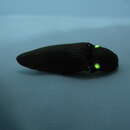en
names in breadcrumbs


Pyrophorus (also known as fire beetles) is a genus of click beetle (family Elateridae). They are one of several genera in the tribe Pyrophorini, all of which are bioluminescent. Their bioluminescence is similar to that of another group of beetles, the fireflies, although click beetles do not flash, but remain constantly glowing (though they can control the intensity; for example, they become brighter when touched by a potential predator). They have two luminescent spots at the posterior corners of the pronotum, and another brighter light organ on the most-anterior surface of the ventral abdomen. This light organ is even brighter and can only be seen when in flight. Bioluminescent click beetles are found throughout tropical, subtropical and temperate America. Species from Texas, Florida, Puerto Rico, and Cuba are now in different genera in the tribe Pyrophorini, such as Deilelater and Ignelater.[1]
Adult Pyrophorus beetles feed on pollen and sometimes small insects, such as aphids or scale insects. Their larvae feed on various plant materials and invertebrates, including the larvae of other beetles. Eggs are luminous and are deposited either on or in the soil. Larvae, like eggs, are luminous. They grow slowly and pupate after an uncertain period of time, but perhaps several years after hatching.
Pyrophorus nyctophanus larvae live in tunnels in the outer layers of termite mounds on the cerrado of Brazil. During summertime they glow at night, attracting prey in the form of other insects.[2]
Pyrophorus (also known as fire beetles) is a genus of click beetle (family Elateridae). They are one of several genera in the tribe Pyrophorini, all of which are bioluminescent. Their bioluminescence is similar to that of another group of beetles, the fireflies, although click beetles do not flash, but remain constantly glowing (though they can control the intensity; for example, they become brighter when touched by a potential predator). They have two luminescent spots at the posterior corners of the pronotum, and another brighter light organ on the most-anterior surface of the ventral abdomen. This light organ is even brighter and can only be seen when in flight. Bioluminescent click beetles are found throughout tropical, subtropical and temperate America. Species from Texas, Florida, Puerto Rico, and Cuba are now in different genera in the tribe Pyrophorini, such as Deilelater and Ignelater.
Adult Pyrophorus beetles feed on pollen and sometimes small insects, such as aphids or scale insects. Their larvae feed on various plant materials and invertebrates, including the larvae of other beetles. Eggs are luminous and are deposited either on or in the soil. Larvae, like eggs, are luminous. They grow slowly and pupate after an uncertain period of time, but perhaps several years after hatching.
Pyrophorus nyctophanus larvae live in tunnels in the outer layers of termite mounds on the cerrado of Brazil. During summertime they glow at night, attracting prey in the form of other insects.